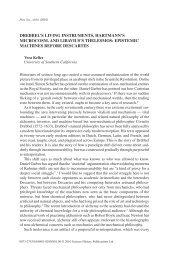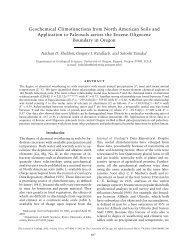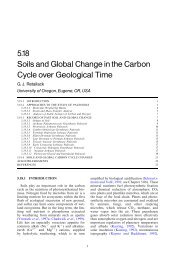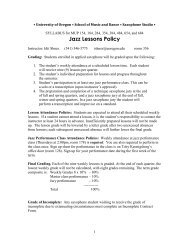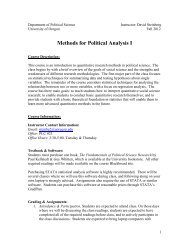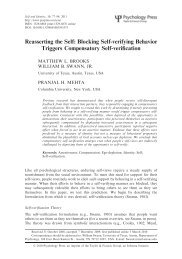Retallack 2007 Proserpina principle - University of Oregon
Retallack 2007 Proserpina principle - University of Oregon
Retallack 2007 Proserpina principle - University of Oregon
Create successful ePaper yourself
Turn your PDF publications into a flip-book with our unique Google optimized e-Paper software.
Record <strong>of</strong> Past Soil and Global Change 19Overlying loessic sedimentDark brown crumbtexturedmollicepipedon (A horizon)79 cmCalcareous nodules(Bk horizon)Figure 13 Tall grassland (Mollisol) paleosol with thick, dark brown crumb-textured surface over a deep(79 cm) white nodular calcic horizon, over a thinner short grassland paleosols with carbonate nodules at adepth <strong>of</strong> 39 cm, in the Late Miocene (7 Ma) Ash Hollow Formation, 13 km north <strong>of</strong> Ellis, Kansas.biomes and their characteristic soils: Mollisols<strong>of</strong> Soil Survey Staff (1999) or Chernozems <strong>of</strong>FAO (1988). Evidence for this transformationin tropical regions comes from the dramaticchange to a less depleted (less negative) carbonisotopic composition (d 13 C) <strong>of</strong> pedogenic carbonateand organic matter, and <strong>of</strong> the apatite<strong>of</strong> fossil mammalian tooth enamel attributed tothe tropical expansion <strong>of</strong> C 4 grasses (Cerlinget al., 1997; MacFadden, 2000). There is alsoevidence from adaptations to grazing in fossilmammals (Janis et al., 2002), from traces <strong>of</strong>grassland invertebrates such as dung beetles(Genise et al., 2000), and from increased abundance<strong>of</strong> silica bodies (phytoliths) and pollencharacteristic <strong>of</strong> grasses (Stro¨ mberg, 2002).Paleosols also demonstrate Late Mioceneexpansion <strong>of</strong> grasslands capable <strong>of</strong> forming sod<strong>of</strong> the sort that is unrolled to create lawns andgolf courses. The dense growth <strong>of</strong> fine (o2mmdiameter) adventitious roots, together with theslime <strong>of</strong> abundant earthworms, create a characteristicsoil structure consisting <strong>of</strong> fine crumbpeds, which can be preserved in paleosols(Figure 13). Grassland soils are also unusuallyrich in organic matter, intimately admixed withclay, <strong>of</strong>ten with as much as 10 wt.% C down toa meter or more, although this organic matteris not always preserved in paleosols. The s<strong>of</strong>t,low-density upper horizons <strong>of</strong> grassland soilsare also rich in mineral nutrients (Ca 2 þ ,Mg 2 þ ,Na þ , and K þ ), and their subsurface horizonscommonly include nodules <strong>of</strong> soil carbonate(usually micritic low magnesium calcite). It haslong been known that such pedogenic nodulesform at shallow depths within soil pr<strong>of</strong>iles indry climates and deeper within the pr<strong>of</strong>ile inmore humid climates (Jenny, 1941; <strong>Retallack</strong>,1994c). Observations <strong>of</strong> depth to carbonatehorizon together with root traces and crumbpeds <strong>of</strong> grassland paleosols can be used to constrainthe paleoclimatic range <strong>of</strong> grasslands(<strong>Retallack</strong>, 1997d, 2001d).Observations on hundreds <strong>of</strong> paleosols in theNorth American Great Plains, <strong>Oregon</strong>, Pakistan,and East Africa have revealed a broadschedule <strong>of</strong> origin and paleoclimatic expansion<strong>of</strong> bunch and then sod grasslands (Figure 14).The increased organic carbon content, high internalsurface area, elevated albedo, and greaterwater retention capacity <strong>of</strong> grasslands comparedwith woodlands <strong>of</strong> comparable climaticregions would have been a potent force forglobal cooling as grasslands emerged to occupyalmost a quarter <strong>of</strong> the current land area (Bestland,2000; <strong>Retallack</strong>, 2001d). Mountain upliftand ocean currents played a role in Neogeneclimate change as well (Raymo and Ruddiman,1992; Ramstein et al., 1997), but there remainproblems with the timing and magnitude <strong>of</strong>carbon sequestration by these physical mechanisms(<strong>Retallack</strong>, 2001d).5.18.3.12 Pleistocene Glacial and InterglacialPaleosolsOver the past million years, large ice capshave grown to engulf the present-day location



